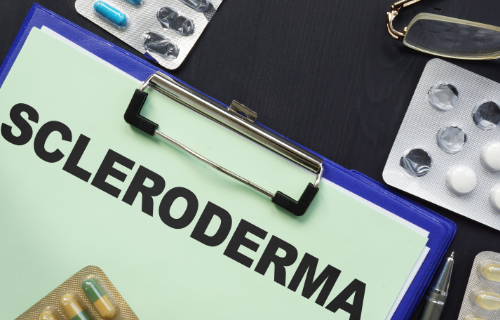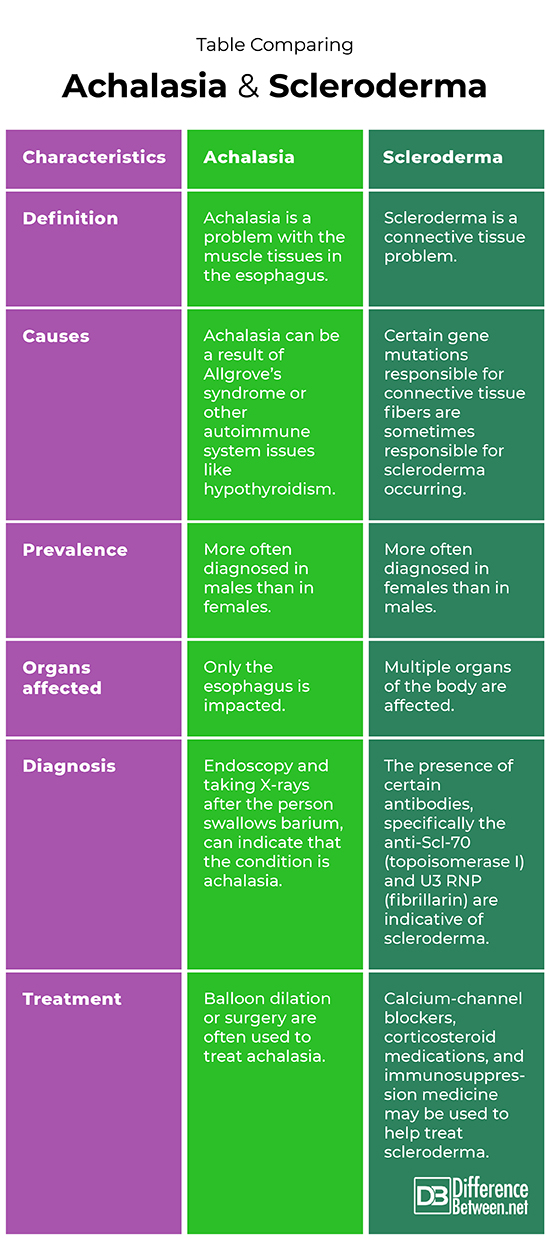Difference Between Achalasia and Scleroderma
Achalasia is a problem of the esophagus and its muscles in which people struggle with swallowing. Scleroderma is a disorder of connective tissue that is caused by immune system dysfunction.

What is Achalasia?
Definition:
Achalasia can be defined as a problem in how the esophagus works because of problems in the muscles of the organ.
Causes and risk factors:
The muscle rings (called sphincters) of the esophagus do not function correctly with achalasia because of medical disorders like autoimmune-linked thyroid problems, Allgrove’s syndrome (a genetic condition), or cancer.
Diagnosis:
Achalasia can be diagnosed based on a barium swallow X-ray and by way of endoscopy. The barium helps show where the problem is because it shows a white color on an X-ray.
Symptoms and complications:
The symptoms of achalasia are difficulty swallowing food and also drinks. People with the condition may feel pain in the chest, regurgitate food, and even belch. A complication is a pneumonia caused by aspirating food and drink into the lungs.
Treatment:
There are ways to widen the esophagus, for instance, by inflating a balloon in the area. In some cases, surgery may be needed to cut away excess tissue causing narrowing of the esophagus.

What is Scleroderma?
Definition:
Scleroderma is an autoimmune disease that is rare but when it occurs it has an adverse impact on the connective tissue of the body, with tissue becoming too stiff.
Causes and risk factors:
The cause of scleroderma is not always known but there are some types of the condition that seem to be linked to gene mutations that affect fibrillin-1, which is a protein involved in forming connective tissue fibers. Exposure to some chemicals like vinyl chloride are suspected of being related to the development of immune dysfunction leading to scleroderma.
Diagnosis:
Diagnosis is based on the symptoms and on antibody testing. Antibodies are proteins that can be used as indicators in the case of some illnesses. In the case of scleroderma, the presence of certain anti-nuclear antibodies, anti-Scl-70 (topoisomerase I) antibodies, and U3 RNP (fibrillarin) antibody can indicate scleroderma.
Symptoms and complications:
Symptoms can include Raynaud’s phenomenon, pain, tightening of the skin (especially over the fingers and toes), swollen extremities, painful joints, problems with swallowing as well as heartburn. The illness can cause complications such as damage to organs like the kidneys, heart, and lungs. These can be deadly.
Treatment:
The aim of treatment is to control symptoms of the condition. Treatment may include the use of corticosteroid medications, calcium-channel blockers, and immunosuppression medicine like mycophenolate. The exact drugs used depend on what effects scleroderma is having on a particular person.
Difference between Achalasia and Scleroderma
Definition
Achalasia is defined as an issue with the muscles of the esophagus. Scleroderma is a connective tissue problem where skin becomes hard.
Causes
Allgrove’s syndrome and cancer can cause achalasia. The cause of scleroderma is not always known but is linked sometimes to a faulty gene that impacts the fibers of connective tissue.
Prevalence
Achalasia is more often diagnosed in males than in females. The opposite is true of scleroderma, which is a lot more common in females than males.
Organs affected
Achalasia only impacts the esophagus but scleroderma impacts many organs all throughout the body.
Diagnosis
The diagnosis of achalasia is by barium X-ray or endoscopy. The diagnosis of scleroderma is by various antibody tests looking for the proteins, specifically, the anti-Scl-70 (topoisomerase I) and U3 RNP antibodies.
Treatment
Treatment options for achalasia can include surgery to open the esophagus or some dilation technique. Treatment options for scleroderma include using different types of medications which can include immune suppressant medicines, calcium channel blockers, or corticosteroids.
Table comparing Achalasia and Scleroderma

Summary of Achalasia and Scleroderma
- Achalasia is a problem of the muscles of the esophagus, leading to issues with swallowing.
- Scleroderma is a problem associated with the connective tissues of the body, which, as a result, impacts several organs in the body.
- Achalasia and scleroderma can both impact the esophagus.
- Both achalasia and scleroderma can have dangerous complications and need to be carefully treated and managed.
FAQ
Is achalasia associated with scleroderma?
Achalasia is not associated with scleroderma; however, dysphagia is commonly linked to scleroderma. Dysphagia is simply difficulty in being able to swallow, which is on occasion, caused by scleroderma in some people.
What can mimic achalasia?
The parasitic infection, Chaga’s disease, can cause problems with how the esophageal muscles contract. This can look like achalasia to the untrained person. Further testing can distinguish the two problems.
Does scleroderma affect the esophagus?
Scleroderma can affect the esophagus because it impacts the tissues of the body. The result is that the esophagus may become constricted in places.
What autoimmune disease causes achalasia?
Thyroid problems, namely Grave’s disease is the autoimmune disease that seems to most commonly cause achalasia.
- Difference Between Rumination and Regurgitation - June 13, 2024
- Difference Between Pyelectasis and Hydronephrosis - June 4, 2024
- Difference Between Cellulitis and Erysipelas - June 1, 2024
Search DifferenceBetween.net :
Leave a Response
References :
[0]Enestvedt, Brintha K., J. Lucas Williams, and Amnon Sonnenberg. "Epidemiology and practice patterns of achalasia in a large multi‐centre database." Alimentary pharmacology & therapeutics 33.11 (2011): 1209-1214.
[1]Nevares, Alana M. “Systemic Sclerosis (Scleroderma)”. Merck Manual, 2020, https://www.msdmanuals.com/professional/musculoskeletal-and-connective-tissue-disorders/autoimmune-rheumatic-disorders/systemic-sclerosis
[2]Patel, Dhyanesh A., Brian M. Lappas, and Michael F. Vaezi. "An overview of achalasia and its subtypes." Gastroenterology & hepatology 13.7 (2017): 411.
